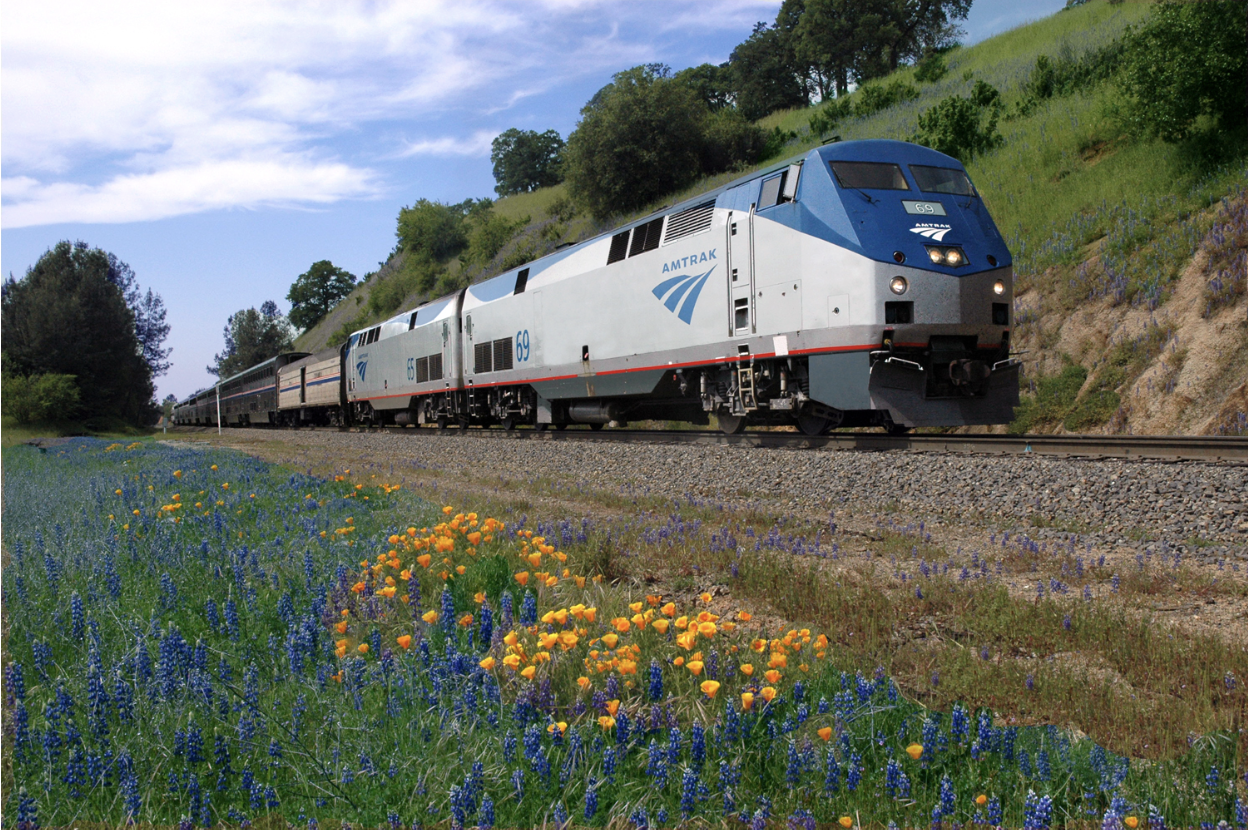
FELIX ZHANG – MARCH 13th, 2023
EDITOR: ARYAN SHAFAT
Since its inception, Amtrak has long been the source of great debate and controversy. Proponents point towards Amtrak’s ability to connect the United States through a network of long-distance and state-operated routes, which have a myriad of economic and environmental benefits compared to other types of transit. Meanwhile, Amtrak’s opponents emphasize the fact that Amtrak has never been profitable in its fifty year history. Is Amtrak just a money wasting vestige of a bygone era that should be abolished? Or does it present a viable and important form of transportation for the future of the country?
Why Does Amtrak Exist?
Amtrak was established under The Congressional Rail Passenger Service Act of 1970 as a way to combine twenty struggling private passenger railroads into a privately controlled but government owned corporation. While over 90% of inter-city travel in the earlier part of the 20th century took place on the nation’s rails, prevailing trends and new technological developments rendered America’s railroads less practical for passengers. Instead of trains being the dominant mode of inter-city travel, many Americans started to shift towards using cars to get around. This was largely prompted by the federal government’s massive funding for the interstate system and support for the automotive industry. Furthermore, a burgeoning airline industry meant that long distances could be reached in shorter times, and often at cheaper prices.
Existing private rail companies such as Penn Central began facing huge deficits in passenger rail, which hurt their profits and took a toll on their more economically viable freight operations. Therefore, the federal government stepped in to consolidate rail operations into one company under Amtrak, with the goal of preserving the most profitable or politically significant routes. Created under Nixon, Amtrak was doomed for failure from the start. On the surface, it was designed as a way to slim down the number of passenger rail routes in the country and take the financial burden off the shoulders of rail companies by shifting the weight onto the federal government. In reality, many railroad companies hoped for abolishment of passenger rail service in totality, believing that rails should only be used for freight travel. Due to the lobbying of freight rail CEOs, Amtrak was not given enough subsidies to even get off the ground. Many, including Nixon and his conservative colleagues, expected that the company would fold within a few years of its initial creation, which would spell the death of passenger rail in the U.S. and allow freight to control America’s extensive rail network.
Furthermore, many of Amtrak’s inherited trains were old, dirty, and in need of heavy maintenance. The infrastructure that was transferred to Amtrak’s management was also aging rapidly and required repairs. However, perhaps the biggest issue of all was that under the Rail Passenger Service Act, Amtrak did not gain ownership of the majority of the railroad tracks that their trains ran on. To this day, 97% of Amtrak’s route miles are owned by other companies, which means that these rails are not maintained with passenger comfort, safety, or speed in mind. In addition, the immense lobbying power of freight rail companies mean that laws cannot be passed or enforced to allow passenger trains to have right of way on freight owned tracks. Freight rail companies justifiably prioritize the timely arrival of their own trains despite existing laws requiring passengers to come first, which often comes at the expense of Amtrak’s schedule.
On Amtrak’s most popular Northeast Regional route that runs between Boston and Washington D.C. with stops in New York and Philadelphia, a rare instance where it owns most of the tracks, trains arrive on schedule 77% of the time. It is no surprise then that the Northeast Corridor accounted for 36% of Amtrak’s total passengers and 52% of its gross ticket revenues in 2020. In fact, the Northeast Regional is one of the few profitable routes for Amtrak, and if Amtrak were run with profit as its first priority, it would certainly focus almost all of its operations in this area. Meanwhile, for most of its long distance routes that involve travel on freight-owned rails, on-time performance is under 60%. On Amtrak’s worst routes, the Capitol Limited and Sunset Limited, trains reach their destination on time a measly 28% of the time. These are the lines where operation costs significantly outweigh ticket revenue for Amtrak, hindering its profitability. Were Amtrak only considering its bottom line, it would likely choose to abolish these routes, but politicians from both sides of the aisle as well as commuters on these train lines find it important to preserve these services as they are often a major part of connecting more rural regions to larger cities.
Throughout Amtrak’s history, the company has never turned a profitable year, but seemed to be demonstrating greater economic viability before the COVID-19 pandemic. Amtrak lost only $29 million on operations in the 2019 fiscal year, and was on track to become profitable for the first time in its history in 2020. Now, post-pandemic, Amtrak expects to continue losing up to $1 billion per year for the foreseeable future as ridership numbers continue to recover and operating expenses trend upwards.
While part of Amtrak’s operations are funded by its route revenues, a considerable part of their budget deficit is compensated through subsidies from state and federal government. Since its creation, Amtrak has received subsidies amounting to over $45 billion dollars, a number that is expected to increase into the future.
An American Problem
Why has Amtrak never been profitable? Is there something systematically holding back rail development in the U.S. compared to other parts of the world? Besides the lack of Amtrak’s rail ownership, which is arguably the biggest factor preventing growth, another reason is the size of the country. From coast to coast, the United States spans well over 2,000 miles at nearly all points, and this simply makes train travel — even running at top speeds — unfeasible compared to the sheer efficiency of flying over such distances. In addition, trains are often caught in the middle ground of political gamesmanship. Politicians who are strongly connected to the oil or car manufacturing lobbies often vocally oppose spending money on Amtrak and improving train infrastructure. This introduces the idea of induced demand – if we build more highways and make cars cheaper through subsidies this will encourage more people to drive. This same postulate has the potential to hold true for rail travel. Creating more routes, establishing cheaper tickets through subsidies and economies of scale, and improving overall supply has the potential to drive up demand for rail travel over time.
However, not everything is so doom and gloom. Even though Amtrak itself might not be making money, those who want to suspend or reduce Amtrak’s operations often fail to recognize that the company’s routes generate between $7 and $8 billion dollars annually in economic activity, over four times the government’s investment in the company. And even though Amtrak’s long distance operations might appear to be bleeding money, many argue that they are in fact an important artery for the stations they serve, connecting small towns to major cities and driving economic growth between different destinations. Furthermore, according to the USDOT, an investment of $1 billion in public transportation creates roughly 36,000 jobs, which could be crucial blue-collar roles in an increasingly automated economy.
While debate about the merits of expanding or contracting train services rage on in the United States, in many other parts of the world, train travel is an integral part of transportation. Part of this has to do with the greater political appeal of train travel in places like Europe. In countries like France and Austria, short-haul flights under two or three hours have been eliminated for government-subsidized airlines, with lawmakers instead promoting rail travel between close-distance cities. The decision is not just popular amongst political elites: a survey found that 62% of Europeans support a ban on short-haul flights.
Whereas trains in the United States often seem outdated, train travel in Europe has also taken on significant innovations in order to become competitive with other modes of transportation, such as the low cost airline industry. In addition to having faster trains that are easily capable of running at speeds in excess of 200 miles per hour, train companies have introduced a variety of services to target different types of customers. In France, SNCF’s Ouigo service connects major metropolitan regions at prices comparable to or below that of low cost airlines, using more barebones high speed trains that charge extra for items like baggage, food, and beverage.
Despite their general success, trains across the world are not perfect. The UK’s privatization of trains in the 1990s has led to a large spike in ticket prices and a poll found that 58% of Britons believed that rail privatization was a partial or complete failure. And trains now have to compete with the low cost airline industry which has blossomed in the past decade. But even in the UK, train ridership has increased drastically with new, faster services being introduced across the country.
Not Just Amtrak:
While there are reasons to doubt the viability of trains in the United States both from a geographical and political standpoint, there is a market that Amtrak can, and must, take advantage of to increase ridership numbers and boost revenues. Rail works best in distances between 100-300 miles, running faster than cars dealing with traffic, and beating the time it takes to get to and from the airport and go through security. While cities in the U.S. are not as compact in distance compared to cities in Japan or France, there are several potentially profitable city pairs currently unserved by Amtrak where expansion could make sense. A rail corridor from Los Angeles to Las Vegas would serve a busy tourist route while alleviating congestion along the I-15 corridor. Further up the coast, enhanced service from Portland to Seattle to Vancouver would improve movement in the Pacific Northwest for a generation of young, environmentally-conscious tech workers.
As Amtrak mulls over its next move, passenger rail in the United States is no longer an operation exclusive to Amtrak. Founded in 2018, Brightline is the first major private passenger rail company established in the U.S. since the creation of Amtrak over five decades ago. Brightline currently connects the cities of southeast Florida, including Miami, Fort Lauderdale, and West Palm Beach. They have also neared completion of new track construction which would connect the train from Miami all the way to Orlando, with trains on the new section running at 125 mph — a far cry, in terms of speed, from its international counterparts but a major improvement compared to other services in the U.S. and a significantly higher speed than motor vehicles. Furthermore, Brightline has proposed the construction of the aforementioned Los Angeles to Las Vegas route, and if their Florida operations prove successful, they would likely target this expansion next. Brightline still needs to demonstrate that it can be a profitable business while competing in the car-centric and airline congested Florida travel market, but it has gained popularity, with ridership in excess of 150% of pre-pandemic levels while most transit organizations across the country struggle to reach 80% of previous riders.
In California, the controversial high speed rail project would connect the cultural and economic powerhouses of San Francisco and Los Angeles, traveling at over 200 miles per hour while stopping along several smaller cities in the state’s Central Valley. Due to project delays and budgetary overruns, the cost of the project has ballooned to an exorbitant $105 billion: a number that could continue to increase into the future. As much as this spending might seem completely overwhelming and unnecessary — there has certainly been mismanagement and needless costs in this project — the benefits of constructing California high speed rail will likely outweigh the astronomical costs. Just the first section running from Bakersfield to Merced is estimated to create 200,000 new jobs, not to mention over 10,000 jobs that have already been generated through the planning and construction of the route. The hope is that California High Speed Rail will incentivize further similar projects through gained experience and proof of success: something Amtrak should have a vested interest in. All of this is without mentioning the biggest benefit of train travel. Just the first Bakersfield to Merced segment is expected to reduce vehicle miles traveled by 284 million miles, which will clear up car congestion and most importantly create significant reductions in the amount of greenhouse gas emissions from transportation. The positive impact of California high speed rail for the environment by reducing car and plane travel cannot be understated, and perhaps will be the most unheralded but important economic impact of the project.
While these projects offer new opportunities for American train travel, many have also called for Amtrak to be simply privatized, a process that has met mixed results worldwide. While the UK’s privatization has led to controversy and a worse customer experience, Japan’s JR rail system was privatized in 1987 into six regional companies that are focused on generating profits. Privatization has enabled JR to leverage their real estate assets and focus on their highly profitable and efficient Shinkansen routes, while government subsidies ensure that they can still serve less high demand communities across the country.
It can also be argued that Amtrak already structurally operates as a private company — just one that won’t shed its least profitable routes due to political factors. Unlike many other transportation authorities in the United States, Amtrak’s goal is to eventually make money from passenger revenues and its leadership structure is similar to that of a corporation. Furthermore, the Congressional Research Project found no evidence that private railway companies would find success outside of the highly profitable Northeast Corridor. If companies like Brightline and projects like California High Speed Rail demonstrate their ability to make money and compete in the U.S. market, this can only be good news for Amtrak and the expansion of rail travel in the United States.
Investing in a New Age of American Rail
How does a company that has never managed to turn a profit in its history expand and grow its operations? Currently, Amtrak’s most important asset is not its trains or rails, but its biggest proponent in the White House. President Joe Biden’s public support for Amtrak is notable compared to his predecessors, and the $1 trillion dollar infrastructure bill has $66 billion set aside in funding for rail. A large part of this $66 billion will go towards improving the Northeast Corridor, including repairing bridges and tunnels, some of which are over 100 years old. These infrastructure upgrades could improve ride times on the critical Northeast Corridor and reduce potential chokepoints, making Amtrak even more competitive compared to planes, buses, and cars.
Furthermore, Amtrak has released a plan to add service to 160 new communities through the addition of 39 new routes and enhancement of 25 routes by 2035. They believe that these network enhancements, which would cost roughly $75 billion dollars to put into action, would result in an additional $7 billion generated in economic activity per year, an investment that would have ripple effects in the rail industry and in the communities that Amtrak would serve. These additions would connect Amtrak to the 50 largest metropolitan areas in the contiguous United States and capitalize on the middle range routes where train travel has proved to be more viable compared to driving or flying. Of course, all of this relies on the support of politicians and freight rail companies, both of which have the power to prevent Amtrak from its ambitious expansion goals.
But why should we support the expansion of a service that has long been losing money and doesn’t show any signs of stopping this trend? Perhaps, the key to Amtrak’s success is realizing that it does not have to be profitable, but instead serve as a tool to the public. Just as governments generally do not expect to break even on building highways or airports, they continue to construct these projects because of the economic activity that they generate, which improves the general welfare of the country’s citizens. This brings up the question about Amtrak’s purpose as a company. Instead of viewing Amtrak as a money-maker, what if we instead looked towards Amtrak’s ability to connect communities, and boost local economies through both business and leisure travel? What if we recognized the power of rail as a better driver for socioeconomic mobility compared to automobile travel, creating new opportunities for employment and education? What if we acknowledged the myriad of environmental benefits of Amtrak’s train services, from lower carbon emissions to taking up fewer precious urban and natural spaces? The next time you hear about how unprofitable Amtrak is, take a moment to think about all the things that are not factored into the bottom line.
Featured Image Source: Amtrak
Disclaimer: The views published in this journal are those of the individual authors or speakers and do not necessarily reflect the position or policy of Berkeley Economic Review staff, the Undergraduate Economics Association, the UC Berkeley Economics Department and faculty, or the University of California, Berkeley in general.



